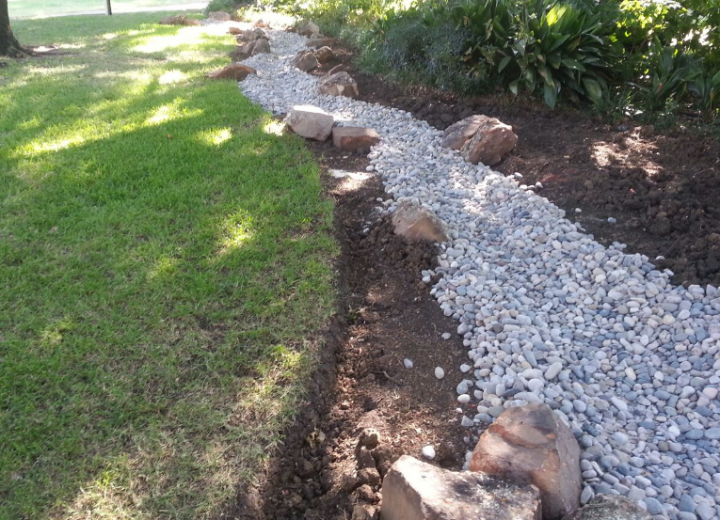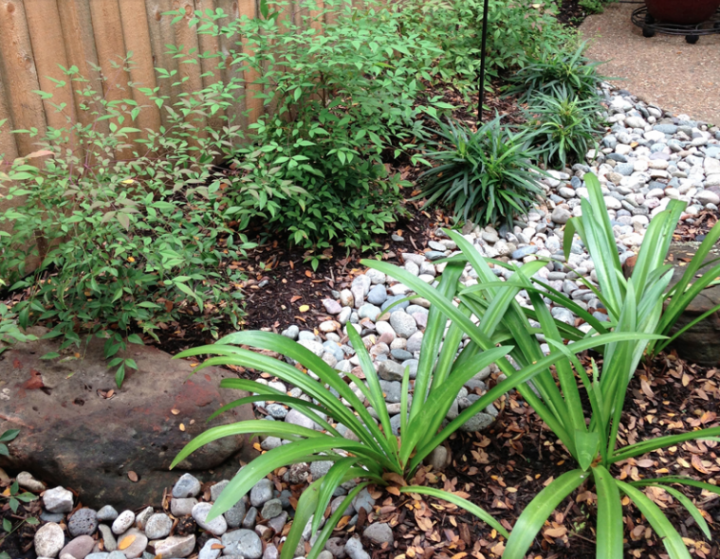Drainage: Can it be attractive and functional? Yes!
January 17, 2017 | By webadmin
Notice water pooling around the areas of the landscape? You could be in need of drainage solutions.
While the winter weather has proven to be fairly dry so far this year, according to Farmer’s Almanac, we should be finding ourselves under quite a few rain clouds towards the end of January and into spring. The big storm a few days ago dropped quite a bit of rain on Dallas. Before more wet weather heads our way, taking steps to improve how water drains through your landscape could save not only your plants, but your established trees and even your home’s foundation.
Functional doesn’t have to mean unattractive.
With each landscape we design, property drainage is often one of the first and most important tasks we need to tackle. Not only do we grade the landscape to control where water drains, but we also look to see where water might most likely pool, causing plants to drown, depleting soils of important nutrients, increasing water runoff and waste, and turning your garden into a muddy mess. One of our favorite ways to combat a soggy landscape is creative hardscaping.
River Rocks Make Soggy Soil Pretty
Swales of river rocks gently twisting through the landscape not only look beautiful, but are highly functional as well. These dry creek beds give water a place to land and absorb or drain through to a street drain or other hardscape structure. These faux river beds also help to move water away from your home’s foundation and other low areas during a heavy storm. With a bit of creativity, we can turn a potential eyesore into a glorious focal point. Best part? Not only can it save your plants, it is virtually maintenance free.

Installing a river rock drainage bed.

Even small landscapes need attention paid to where its water is draining.
Alternative ways to combat poor drainage
A French Drain is a 12” trench filled with gravel and a pipe with holes in the bottom to help water seep down into the ground below and also drives water away from that specific area. As water builds up in the trench, it enters the drainage pipe through small holes on the bottom of the pipe. Installing a French drain beneath a roof line or a gutter can help direct water away from your home’s foundation.
Grading defines the slope of your property and where water flows. If your irrigation or rainfall is flowing towards your house or other structures on property, then you could need re-grading. Poor grading also causes lawns to have dips, causing it to die off in places. Re-grading, along with drains, solve many excess moisture issues in the landscape.
Dense plantings of certain types of root-dense plants (such as ornamental grasses), when strategically placed, can help slow down or stop water runoff and soil erosion in your property. Slopes can be especially challenging in this regard - plants are often an attractive and effective solution.
How healthy is your soil? If you have poorly amended soil, then it most likely doesn’t drain well. Our heavy, compacted clay soils hold a lot of water during heavy rains. This can cause suffocated roots, a lack of oxygen and a host of other issues. Aerating and feeding your soil will improve drainage by changing its texture, allowing it to both breathe and drain properly.
Save money, your plants and time by installing drainage solutions now. With our extreme and unpredictable weather, you never know if a giant rainstorm is just around the corner, waiting to cause destruction to your landscape.
